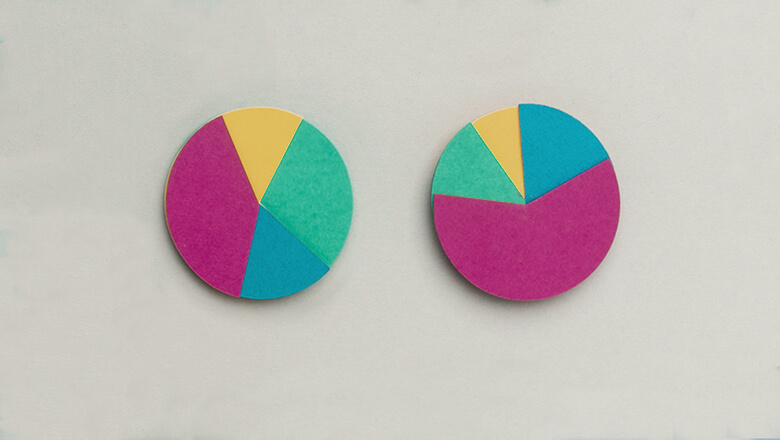Asset Allocation by Age, Explained
Asset allocation is an investment strategy that helps you decide the ratio of different asset classes in your portfolio to ensure that your investments align with your risk tolerance, time horizon, and goals.
In other words, the way you allocate, or divide up the assets in your portfolio helps to balance risk, while aiming for the highest return within the time period you have to achieve your investment goals.
How do you set your portfolio to get the best asset allocation by age? Here’s what you need to know about asset-based asset allocation.
Key Points
• Asset allocation is the process of dividing investments among different asset classes based on factors like age, risk tolerance, and financial goals.
• Younger investors can typically afford to take more risks and allocate a higher percentage of their portfolio to stocks.
• As investors approach retirement, they may shift towards a more conservative asset allocation, with a higher percentage allocated to bonds and cash.
• Regularly reviewing and rebalancing your asset allocation is important to ensure it aligns with your changing financial circumstances and goals.
• Asset allocation is a personal decision and should be based on individual factors such as risk tolerance, time horizon, and investment objectives.
What Is Age-Based Asset Allocation?
The mix of assets you hold will likely shift with age. When you’re younger and have a longer time horizon, you might want to hold more stocks, which offer the most growth potential. Also, that longer time horizon gives you plenty of years to help ride out volatility in the market.
You will likely want to shift your asset allocation as you get older, though. As retirement age approaches, and the point at which you’ll need to tap your savings draws near, you may want to shift your retirement asset allocation into less risky assets like bonds and cash equivalents to help protect your money from downturns.
In the past, investment advisors recommended a rule of thumb whereby an investor would subtract their age from 100 to know how much of their portfolio to hold in stocks. What is an asset allocation that follows that rule? A 30-year-old might allocate 70% of their portfolio to stocks, while a 60-year-old would allocate 40%.
However, as life expectancy continues to increase — especially for women — and people rely on their retirement savings to cover the cost of longer lifespans (and potential healthcare expenses), some industry experts and advisors now recommend that investors keep a more aggressive asset allocation for a longer period.
The new thinking has shifted the formula to subtracting your age from 110 or 120 to maintain a more aggressive allocation to stocks.
In that case, a 30-year-old might allocate 80% of their portfolio to stocks (110 – 30 = 80), and a 60-year-old might have a portfolio allocation that’s 50% stocks (110 – 60 = 50) — which is a bit more aggressive than the previous 40% allocation.
These are not hard-and-fast rules, but general guidelines for thinking about your own asset allocation strategy. Each person’s financial situation is different, so each portfolio allocation will vary.
💡 Quick Tip: All investments come with some degree of risk — and some are riskier than others. Before investing online, decide on your investment goals and how much risk you want to take.
Asset Allocation Models by Age
As stated, age is a very important consideration when it comes to strategic asset allocation. Here are some asset allocation examples for different age groups.
Asset Allocation in Your 20s and 30s
For younger investors, the conventional wisdom suggests they may want to hold most of their portfolio in stocks to help save for long-term financial goals like retirement.
That said, when you’re young, your financial footing may not be very secure. You probably haven’t built much of a nest egg, you may change jobs relatively frequently, and you may have debt, such as student loans, to worry about. Setting up a potentially volatile, stock-focused allocation might feel nerve-wracking.
If you have a 401(k) at work, this might be your primary investment vehicle — or you may have set up an IRA. In either account you can invest in mutual funds or exchange-traded funds (ETFs) that hold a mix of stocks, providing some low-cost diversification without sacrificing the potential for long-term growth.
You could also invest in a target date fund, which is designed to help to manage your asset allocation over time (more on these funds below).
When choosing funds, it’s important to consider both potential performance and fees. Index funds, which simply mirror the performance of a certain market index, may carry lower expense ratios but they may generate lower returns compared to, say, a growth fund that’s more expensive.
Remember that the younger you are, the longer you have to recover from market downturns or losses. So allocating a bigger chunk of your investments to growth funds or funds that use an active management strategy could make sense if you feel their fees are justified by the potential for higher returns — and the higher risk that comes along with it.
And of course, you can counterbalance higher-risk/higher-reward investments with bonds or bond funds (as a cushion against volatility), index funds (to help manage costs) or target date funds (which can do a bit of both). Just be aware that the holdings within some funds can overlap, which could hamper your diversification strategy and require you to choose investment carefully.
Asset Allocation in Your 40s and 50s
As you enter middle age you are potentially entering your peak earning years. You may also have more financial obligations, such as mortgage payments, and bigger savings goals, such as sending your kids to college, than you did when you were younger. On the upside, you may also have 20 years or more before you’re thinking about retiring.
In the early part of these decades, one approach is to consider keeping a hefty portion of your portfolio still allocated to stocks. This may be useful if you haven’t yet been able to save much for your retirement because you’d be able to add potential growth to your portfolio, and still have some years to ride out any volatility.
Depending on when you plan to retire, adding stability to your portfolio with bonds as you approach the latter part of these decades might be a wise choice. For example, you may want to begin by shifting more of your IRA assets to bonds or bond funds at this stage. These investments may produce lower returns in the short term compared to mutual funds or ETFs. But they can be useful for generating income once you’re ready to begin making withdrawals from your accounts in retirement.
Asset Allocation in Your 60s
Once you hit your 60s and you’re nearing retirement age, your allocation will likely shift toward fixed-income assets like bonds, and maybe even cash. A shift like this can help prepare you for the possibility that markets may be down when you retire.
If that’s the case, you might be able to use these fixed-income investments to provide income during the downturn, so you can avoid selling stocks while the markets are down since doing so would lock in losses and might curtail future growth in your portfolio. Thus, leaning on the fixed-income portion of your portfolio allows time for the market to recover before you need to tap into stocks.
If you haven’t retired yet, you can continue making contributions to your 401(k) to grow your nest egg and take advantage of any employer match.
If you chose to invest in a target date fund within your retirement account when you were younger, it’s likely that fund’s allocation would now be tilting toward fixed-income assets as well.
Retirement Asset Allocation
Once you’ve retired it may seem like you can kick back and relax with all of your asset allocation worries behind you. Yet, your portfolio allocation is as important to consider now as it was in your 20s.
When you retire, you’ll likely be on a fixed income — and you won’t be adding to your savings with earned wages. Your retirement could last 20 to 30 years or more, so consider holding a mix of assets that includes stocks that might provide some growth. Keeping a modest stock allocation might help you avoid outliving your savings and preserve your spending power.
While that may sound contrary to the suggestion above for pre-retirees to keep more of their assets allocated to fixed-income, the difference is the level of protection you might want just prior to retirement. Now as an official retiree, and thinking about the potential decades ahead, you may want to inject a little growth potential into your portfolio.
It might also make sense to hold assets that grow faster than the rate of inflation or are inflation-protected, such as Treasury Inflation-Protected Securities, or TIPS, which can help your nest egg hold its value.
These are highly personal decisions that, again, go back to the three intersecting factors that drive asset allocation: your goals, risk tolerance, and time horizon. There’s no right answer; the task is arriving at the right answer for you.
Understanding Assets and Asset Classes
At its heart, a financial asset is anything of value that you own, whether that’s a piece of property or a single stock. When you invest, you’re typically looking to buy an asset that will increase in value.
The three broad groups, or asset classes, that are generally held in investment accounts are stocks, bonds, and cash. When you invest, you will likely hold different proportions of these asset classes.
Asset Allocation Examples
What are some asset allocation examples? Well, your portfolio might hold 60% stocks, 40% bonds, and no cash — or 70% stocks, 20% bonds, and 10% in cash or cash equivalents. But how you decide that ratio gets into the nuts and bolts of your actual asset allocation strategy, because each of these asset types behaves differently over time and has a different level of risk and return associated with it.
• Stocks. Stocks typically offer the highest rates of return. However, with the potential for greater reward comes higher risk. Typically, stocks are the most volatile of these three categories, especially in the short term. But over the long term, the return on equities (aka stocks) has generally been positive. In fact, the S&P 500 index, a proxy for the U.S. stock market, has historically returned an average of 10% annually.
• Bonds. Bonds are traditionally less risky than stocks and offer steadier returns. A general rule of thumb is that bond prices move in the opposite direction of stocks.
When you buy a bond, you are essentially loaning money to a company or a government. You receive regular interest on the money you loan, and the principal you paid for the bond is returned to you when the bond’s term is up. When buying bonds, investors generally accept smaller returns in exchange for the security they offer.
• Cash. Cash, or cash equivalents, such as certificates of deposit (CDs) or money market accounts, are the least volatile investments. But they typically offer very low returns.
💡 Quick Tip: Are self-directed brokerage accounts cost efficient? They can be, because they offer the convenience of being able to buy stocks online without using a traditional full-service broker (and the typical broker fees).
Get up to $1,000 in stock when you fund a new Active Invest account.*
Access stock trading, options, auto investing, IRAs, and more. Get started in just a few minutes.
*Customer must fund their Active Invest account with at least $25 within 30 days of opening the account. Probability of customer receiving $1,000 is 0.028%. See full terms and conditions.
How Do Diversification and Rebalancing Fit In?
The old adage, “Don’t put all your eggs in one basket,” is apt for a number of concepts in investing.
Putting all of your money in one investment may expose you to too much risk. When it comes to asset allocation, you can help manage risk by spreading money out over different asset classes that are then weighted differently within a portfolio.
Here is a possible asset allocation example: If your stock allocation was 100%, and the stock market hit a speed bump, your entire portfolio could lose value. But if your allocation were divided among stocks, bonds, and cash, a drop in the value of your stock allocation wouldn’t have the same impact. It would be mitigated to a degree, because the bonds and cash allocation of your portfolio likely wouldn’t suffer similar losses (remember: bond prices generally move in the opposite direction of stocks, and cash/cash equivalents rarely react to market turmoil).
Diversification
Portfolio diversification is a separate, yet related, concept. Simple diversification can be achieved with the broader asset classes of stocks, bonds, and cash. But within each asset class you could also consider holding many different assets for additional diversification and risk protection.
For example, allocating the stock portion of your portfolio to a single stock may not be a great idea, as noted above. Instead, you might invest in a basket of stocks. If you hold a single stock and it drops, your whole stock portfolio falls with it. But if you hold 25 different stocks — when one stock falls, the effect on your overall portfolio is relatively small.
On an even deeper level, you may want to diversify across many types of stock — for example, varying by company size, geography, or sector. One way some investors choose to diversify is by holding mutual funds, index funds, or ETFs that themselves hold a diverse basket of stocks.
Rebalancing
What is rebalancing? As assets gain and lose value, the proportion of your portfolio they represent also changes. For example, say you have a portfolio allocation that includes 60% stocks and the stock market ticks upward. The stocks you hold might have appreciated and now represent 70% or even 80% of your overall portfolio.
In order to realign your portfolio to your desired 60% allocation, you might rebalance it by selling some stocks and buying bonds. Why sell securities that are gaining value? Again, it’s with an eye toward managing the potential risk of future losses.
If your equity allocation was 60%, but has grown to 70% or 80% in a bull market, you’re exposed to more volatility. Rebalancing back to 60% helps to mitigate that risk.
The idea of rebalancing works on the level of asset allocation and on the level of asset classes. For example, if your domestic stocks do really well, you may sell a portion to rebalance your dometic allocation and buy international stocks.
You can rebalance your portfolio at any time, but you may want to set regular check-ins, whether quarterly or annually. There may be no need to rebalance if your asset allocation hasn’t really shifted. One general rule to consider is the suggestion that you rebalance your portfolio whenever an asset allocation changes by 5% or more.
What’s the Deal with Target Date Funds?
One tool that some investors find useful to help them set appropriate allocations is a target date fund. These funds, which were described briefly above, are primarily for retirement, and they are typically geared toward a specific retirement year (such as 2030, 2045, 2050, and so on).
Target funds hold a diverse mix of stocks and fixed-income investments. As the fund’s target date approaches, the mix of stocks and bonds the fund automatically adjusts to a more conservative allocation — aka the fund’s “glide path.”
For example, if you’re 35 and plan to retire at 65, you could purchase shares in a target-date fund with a target date 30 years in the future. While the fund’s stock allocation may be fairly substantial at the outset, as you approach retirement the fund will gradually increase the proportion of fixed-income assets that it holds.
Target-date funds theoretically offer investors a way to set it and forget it. However, they also present some limitations. For one, you don’t have control over the assets in the fund, nor do you control how the fund’s allocation adjusts over time.
Target funds are typically one-size-fits-all, and that doesn’t always work with an individual’s unique retirement goals. For example, someone aggressively trying to save may want to hold more stocks for longer than a particular target date fund offers. Also, as actively managed funds, they often come with fees that can take a bite out of how much you are ultimately able to save.
The Takeaway
While many investors spend time researching complex issues like bond yields and options trading, understanding and executing a successful asset allocation strategy — one that works for you now, and that you can adjust over the long term — can be more challenging than it seems.
Although asset allocation is a fairly simple idea — it’s basically how you divide up different asset classes in your portfolio to help manage risk — it has enormous strategic implications for your investments as a whole. The three main factors that influence your asset allocation (goals, risk tolerance, and time horizon) seem straightforward enough as separate ideas, yet there is an art and a science to combining them into an asset allocation that makes sense for you. Like so many other things, arriving at the right asset allocation is a learning process.
Ready to invest in your goals? It’s easy to get started when you open an investment account with SoFi Invest. You can invest in stocks, exchange-traded funds (ETFs), mutual funds, alternative funds, and more. SoFi doesn’t charge commissions, but other fees apply (full fee disclosure here).
You may also be interested in:
Third-Party Brand Mentions: No brands, products, or companies mentioned are affiliated with SoFi, nor do they endorse or sponsor this article. Third-party trademarks referenced herein are property of their respective owners.
Financial Tips & Strategies: The tips provided on this website are of a general nature and do not take into account your specific objectives, financial situation, and needs. You should always consider their appropriateness given your own circumstances.
SoFi Invest®
INVESTMENTS ARE NOT FDIC INSURED • ARE NOT BANK GUARANTEED • MAY LOSE VALUE
SoFi Invest encompasses two distinct companies, with various products and services offered to investors as described below:
Individual customer accounts may be subject to the terms applicable to one or more of these platforms.
1) Automated Investing and advisory services are provided by SoFi Wealth LLC, an SEC-registered investment adviser (“SoFi Wealth“). Brokerage services are provided to SoFi Wealth LLC by SoFi Securities LLC.
2) Active Investing and brokerage services are provided by SoFi Securities LLC, Member FINRA (www.finra.org)/SIPC(www.sipc.org). Clearing and custody of all securities are provided by APEX Clearing Corporation.
For additional disclosures related to the SoFi Invest platforms described above please visit SoFi.com/legal.
Neither the Investment Advisor Representatives of SoFi Wealth, nor the Registered Representatives of SoFi Securities are compensated for the sale of any product or service sold through any SoFi Invest platform.
SOIN0723103











